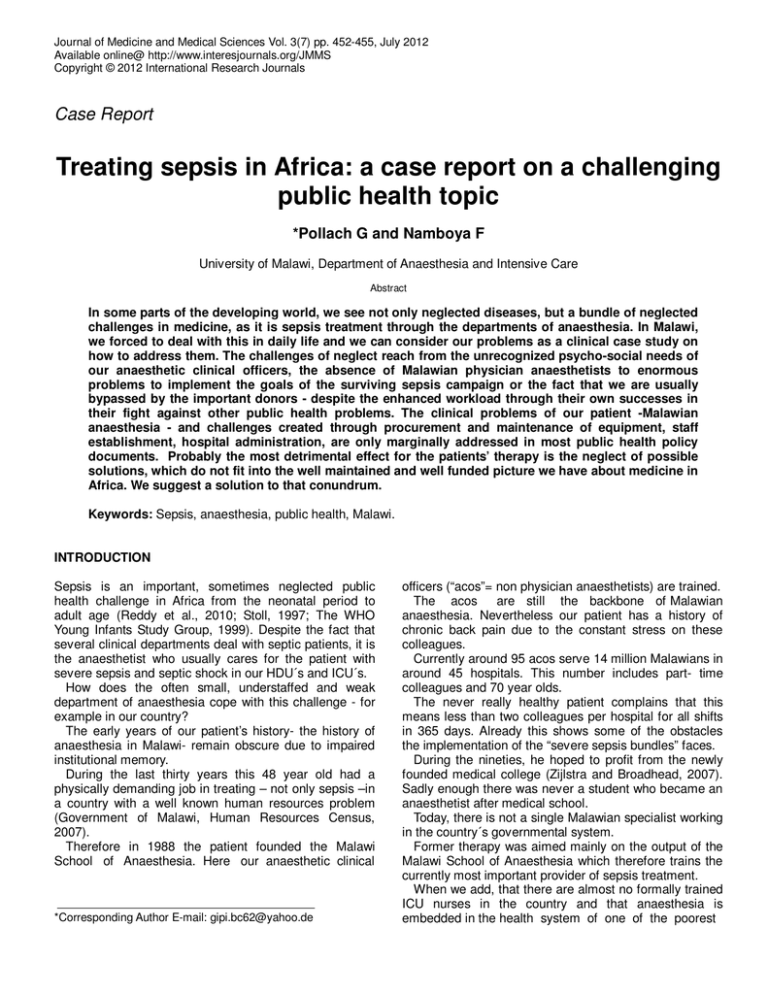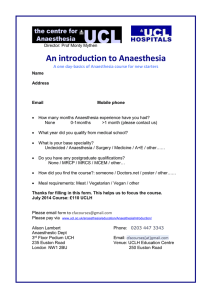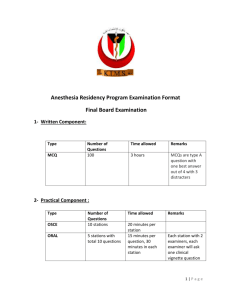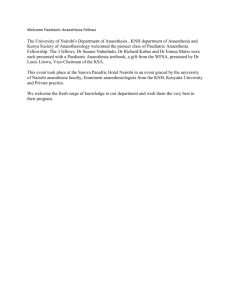Document 14233487
advertisement

Journal of Medicine and Medical Sciences Vol. 3(7) pp. 452-455, July 2012 Available online@ http://www.interesjournals.org/JMMS Copyright © 2012 International Research Journals Case Report Treating sepsis in Africa: a case report on a challenging public health topic *Pollach G and Namboya F University of Malawi, Department of Anaesthesia and Intensive Care Abstract In some parts of the developing world, we see not only neglected diseases, but a bundle of neglected challenges in medicine, as it is sepsis treatment through the departments of anaesthesia. In Malawi, we forced to deal with this in daily life and we can consider our problems as a clinical case study on how to address them. The challenges of neglect reach from the unrecognized psycho-social needs of our anaesthetic clinical officers, the absence of Malawian physician anaesthetists to enormous problems to implement the goals of the surviving sepsis campaign or the fact that we are usually bypassed by the important donors - despite the enhanced workload through their own successes in their fight against other public health problems. The clinical problems of our patient -Malawian anaesthesia - and challenges created through procurement and maintenance of equipment, staff establishment, hospital administration, are only marginally addressed in most public health policy documents. Probably the most detrimental effect for the patients’ therapy is the neglect of possible solutions, which do not fit into the well maintained and well funded picture we have about medicine in Africa. We suggest a solution to that conundrum. Keywords: Sepsis, anaesthesia, public health, Malawi. INTRODUCTION Sepsis is an important, sometimes neglected public health challenge in Africa from the neonatal period to adult age (Reddy et al., 2010; Stoll, 1997; The WHO Young Infants Study Group, 1999). Despite the fact that several clinical departments deal with septic patients, it is the anaesthetist who usually cares for the patient with severe sepsis and septic shock in our HDU´s and ICU´s. How does the often small, understaffed and weak department of anaesthesia cope with this challenge - for example in our country? The early years of our patient’s history- the history of anaesthesia in Malawi- remain obscure due to impaired institutional memory. During the last thirty years this 48 year old had a physically demanding job in treating – not only sepsis –in a country with a well known human resources problem (Government of Malawi, Human Resources Census, 2007). Therefore in 1988 the patient founded the Malawi School of Anaesthesia. Here our anaesthetic clinical *Corresponding Author E-mail: gipi.bc62@yahoo.de officers (“acos”= non physician anaesthetists) are trained. The acos are still the backbone of Malawian anaesthesia. Nevertheless our patient has a history of chronic back pain due to the constant stress on these colleagues. Currently around 95 acos serve 14 million Malawians in around 45 hospitals. This number includes part- time colleagues and 70 year olds. The never really healthy patient complains that this means less than two colleagues per hospital for all shifts in 365 days. Already this shows some of the obstacles the implementation of the “severe sepsis bundles” faces. During the nineties, he hoped to profit from the newly founded medical college (Zijlstra and Broadhead, 2007). Sadly enough there was never a student who became an anaesthetist after medical school. Today, there is not a single Malawian specialist working in the country´s governmental system. Former therapy was aimed mainly on the output of the Malawi School of Anaesthesia which therefore trains the currently most important provider of sepsis treatment. When we add, that there are almost no formally trained ICU nurses in the country and that anaesthesia is embedded in the health system of one of the poorest Pollach and Namboya 453 countries in the world we have to admire the patients persistency and his will to survive. Presentation The patient presents with dyspnoe during his daily performance, due to an extreme shortage of staff. It is hard for him to deal with his daily life duties. Coping with more patients in severe sepsis than ever can be admitted to ICU, a maternal mortality of almost 1%, an 5 HIV rate of 14 %, a population growth of 3% and one of the highest road traffic accident mortalities in the world is more than you can ask from such a weak and badly supported specialty. Consequently Malawi suffers from a lot of fatalities due to severe sepsis and septic shock. His condition is further deteriorating by constant wasting due to PEM - Procurement, Establishment and Maintenance is adversaries having the potential to kill even the strongest of the countries anaesthesia departments. Examination On clinical examination we find a variety of symptoms. Without dedication there is no treatment for sepsis. EGDT (Early Goal Directed Therapy – the mainstay of sepsis treatment) needs a lot of work done in the first 6 hours. Why is the patient’s dedication and commitment inconstant? This is the question what dedication you can expect for less than 250 Euro/ month? Continuous staff rotation prevents everybody from learning anything. One ICU suffered from 4 head nurses in less than three years, which wasn´t the worst for capacity building because the hospital dealt with eight hospital directors during the same time. What can the patient do with nurses sleeping in ICU on nightshift, because they have to rest for another job the next morning instead of using the most important first hours of treatment? Around 14% of the patient´s staff is reactive, they suffer from Malaria (another septicaemic disease), a lacking career path for acos and a continuing internal brain drain. Inspection and palpation reveal a second reason for a poor nutritional status with PEM. The widespread lack of Professional Expertise in the hospitals Management. Every malnourish patient is very much prone to sepsis. Percussion proofs diffuse tenderness around the point of cultural sensitivity. Every problem is revered to be a cultural sensitive challenge - instead of a problem to be solved. Auscultation shows suspicion of aspiration of too many short term foreign consultants as a septic focus. Investigations Ultrasound reveals challenges in good governance with concerns in centralization, allocation of funds, allowances and patronage. Information about the overall financial situation of the patient remains patchy due to impenetrable acoustic shadows. Chest X-ray shows a black side trough the almost complete absence of interns and registrars on the side of anaesthesia. A tension pneumothorax with sudden decomposition of anaesthesia services has to be seen as a real possibility. Lab tests for signs of infrastructure are highly pathological. Communication means and general management structures show severe deficits - both are harmful in the treatment of a disease like sepsis where so much depends on interdepartmental communication. Blood cultures reveal a lack of preemptive culture. Predominantly this is true in procurement (a long, bureaucratic, complicated process), maintenance (knowledge, spare parts, efforts made), replacement (communication, accountability), resource-management (of our scarcy ones), prioritizing (what is an emergency?), and centralization (few local decisions). DISCUSSION In order to cover all tasks in which the implementation of the “Surviving Sepsis campaign” involves a department of anaesthesia – we need to deal with the patient threatening African “Big Five”: “Modify Management Means More Money.” Modify the effects of fraud, embezzlement, power struggles, tribalism, witchcraft and nepotism. We still have to minimize the effects of too much adopting instead of adapting. In sepsis this means adapting the strategy to the local possibilities. We need guidelines adequate for an environment characterized by the contradiction of having sometimes nice studies with PCR or MRI machines, but being unable to pay oxygen, spinal needles or the measurement of potassium and running water in our ICU. Moreover the tropics are no kindergarden for junior doctors to push their career with a PhD, but for hard working clinicians. Management improvement in the procurement of antibiotics, in the establishment of critical care staff, in the maintenance of equipment like ventilators and monitors and in the administration of hospitals and human resources departments (firing of lazy colleagues) means to lay the foundations of capacity building in the treatment of septic patients. Clinical medicine must have the lead in hospitals as 454 J. Med. Med. Sci. long as we have sick patients. Only when patients start to come to hospitals because their main problem is the wish to be administered- than clinical medicine can retire from leadership. Means are needed to keep the dedication of our acos, doctors and nurses alive. First and foremost a decent salary, so that our collaborators don´t need to sleep on ICU to recover from their second or third job; locums have to be payed and the pest of allowances has to be eradicated. Continuous education and coverage for their own health problems has to be established. More acos and anaesthetists are needed. We need backbone and leadership. Aco´s alone will have difficulties to lift anaesthesia to the level needed (as mortality rates from countries with an aco driven anaesthesia suggest6 for sufficient sepsis care. The limit towards a self sustaining system, which is able to implement the Surviving Sepsis Campaign can only, be reached with a minimum of supervision, leadership and planning through experienced specialists- strategically positioned. Money: We do need more money. Anaesthesia gets more referrals from better trained personal in the health centers; patients survive longer by antiretroviral therapy and reach the theatres and ICU/HDUs in a bad but manageable condition. Sepsis in these patients is difficult to treat and they stay in ICU for a long time - treated with resources from a department, which does not receive any money from the big donors (Global fund, Gates, Unicef, Universities doing research). Instead we see the money flowing into non patient touching, 1700 hours closing, theoretical professions (epidemiology, public health, statistics, health economics…), which take the money away from the guys doing the real work – a work which starts at midnight. Obviously there is no „trickling down“ towards sepsis care on ICU and the rest of anaesthesia through the tight gaps of the well established beneficiaries in the business. These gaps are in dire need of bridging (Baelani et al., 2011). Diagnosis Semi acute septic exacerbation of neglected insufficiencies in a chronically under resourced specialty due to aids, sepsis, rtas and an impenetrable fund allocation. Management and outcome As in all critically ill septic patients we have to provide symptomatic relief and specific treatment to prevent fatal multiorgan failure. Our patient is forced to struggle permanently with a lot of adversities. Even when we help him through donor sponsored physiotherapy and he strains all his muscles this will exhaust his ability to deliver and he will need artificial support. There are several syndromes responsible for this; especially the “syndrome of elitism” and the frightening” no patient but pencil touching syndrome” as well as the “no nightshift syndrome”. Like sepsis they are systemic diseases needing a systemic approach to fight them. The condition constantly worsens by the fruitless work and movements caused by Procurement, Establishment and Administration. They might force him into a PEA (Pulse less Electrical Activity) situation from which he will recover only with difficulties. There is the real danger of the infamous entrapment– the most significant symptoms being the lack of Malawian specialists and the dependency from foreign anaesthetists and their contacts, courses, allowances and donations. Obviously our patient lives at the edge of decomposition. The patient cannot be admitted to ICU due to overcrowding and competing other health problems in the country. Meaning we cannot go on only with the old solutions (Becker et al., 2009; Hodges et al., 2007). Because we are not living in an ideal world there is no optimal solution to these challenges - but a “sepsisbundle” of five drugs is mandatory: Dedication- is needed from the patient himself. That means that the acos and doctors in anaesthesia have to be enabled to make a decent living from one job only. Opportunity- has to be given to the colleagues to do the work they are supposed to do (basic drugs, lab tests, ventilators, transport, housing, medical aid, schooling for their children). Without that there never will be an implementation of a standardized sepsis treatment. Numbers- As a new therapeutic concept we currently train the first physician anaestetists ever in Malawi. Hopefully the five colleagues will be the founding stone of our specialty as a Malawian specialty – including the cornerstone of a sense for standardized resuscitation and management of septic patients. Additionally the Malawi School of Anaesthesia must be supported and its output enhanced. Knowledge- about the own disease has to be spread by refresher courses, CME and formal training for all cadres in the guidelines of the “surviving sepsis campaign” has to be spread over the country (Dellinger et al., 2004). For the time being we still need foreign doctors to help us– so please do come for a year and take sepsis care in Malawi to a new level! Elimination- of adverse effects through the patient threatening killing “Big Five“. Yes– we want! We do belief, that this patient has the chance to experience a long, difficult road to recovery. On this way our patient needs the stubbornness of a donkey (D: Dedication, O: Opportunity, N: Numbers, K: Knowledge, E: Elimination, Y: Yes we want!) This enormous task cannot be achieved by changing Pollach and Namboya 455 foreign doctors. That’s the reason why we need to train Malawian doctors in anaesthesia – Malawians have to lead the DONKEY- Therapy! REFERENCES Baelani I, Jochberger S, Laimer T, Otieno D, Kabuta J, Wilson I, Baker T, Duenser MW (2011). Availability of critical care resources to treat patients with severe sepsis or septic shock in Africa: a self – reported, continent - wide survey of anaesthesia providers. Critical Care 15: R10 Becker JU, Theodosis L, Jacob ST, Wira CR, Grace NE (2009). Surviving sepsis in low-income and middle-income countries: new directions for care and research. Lancet Infect. Dis. 9: 577-582 Dellinger RP, Carlet J, Masur H, Gerlach H, Calandra T, Cohen J, GeaBanodacke J, Keh D, Marshall J, Parker MM, Ramsey G, Zimmermann JL, Vincent Jl, Levy MM (2004).Surviving Sepsis Campaign for management of severe sepsis and septic shock. Crit. Care Med. 32:858-872. Hodges SC, Mijumbi C, Okello M, Mc Cormick BA, Walker IA, Wilson IH (2007). Anaesthesia services in developing countries: defining the problems, Anaesthesia, 62:4-11 Malawi Demographic and Health Survey (2004). National Statistical Office, Zomba Malawi, ORC Macro Calverton, Maryland, USA, 2(453):XXII Ouro-Bang´naMaman, Tomta M, Ahouangbevi S, Chobli M (2005). Deaths associated with anaesthesia in Togo, West Africa, Tropical Doctor 35:220-222 Reddy EA, Shaw AV, Crump JA (2010). Community –acquired bloodstream infections in Africa: a systematic review and metaanalysis, Lancet Infect Dis. 10: 417-32. Stoll BJ (1997). The global impact of neonatal infection, Clin. Perinatol.24:1-21 The WHO Young Infants Study Group (1999). Serious infections in young infants in developing countries: rationale for a multicenter study. Pediatr. Infect Dis. J. 18:S4-71 Zijlstra Ed E, Broadhead RL (2007). The College of Medicine in the Republic of Malawi: towards sustainable staff development. Human Resources for Health 5: 10-11





